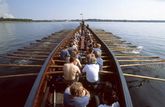The recreated ship
Thanks to a donation from the Tuborg Fund, the Viking Ship Museum reconstructed the 30-metre-long Viking warship, Skuldelev 2. The original ship is exhibited in the Viking Ship Hall. It was built in the vicinity of Dublin, Ireland, during the 1040s by shipwrights well versed in Scandinavian boatbuilding traditions. By reconstruction the ship one sight on the past have to be renewed. Practical questions have to be answered in the building process and during the sailing tours with the ships.
Building a Viking longship was an impressive task. Preparing and treating all the necessary materials must have involved most of the families in the area. The work spread over the surrounding countryside, and effective organisation was required to ensure that everything meshed smoothly at the boatyard.
Olaf Tryggvason's saga tells of the many people involved in building the longship called Long Serpent. A master shipwright had overall responsibility. Beneath him, a 'prow smith' was responsible for laying the prows and keel, while 'shipsmiths' built the ship. The saga also describes the people who felled the trees, cleaved and hewed the planks, transported the timber to the shipyard and hammered in the nails.
It took a single winter to build Long Serpent. The Viking Ship Museum spend ca. 44,000 effective man-hours reconstructing the hull of Skuldelev 2. Assuming that a master shipwright and 10 shipsmiths are able to work on the ship at a time, and also including the previously mentioned assistants, it would be possible to build the ship in seven months. At the same time, tar, rope, sail, etc. must also be produced.
Power and wealth were required to build, equip and man a Viking longship. The ships mentioned in the accounts of the time were all built at the request of a king or nobleman. The weaponry and other supplies were almost as valuable as the ship itself. Swords, shields, longbows, arrows, helmets, axes and coats of ring mail were required on board, as were provisions, drinking water, blankets, tents and personal effects. Probably, most of the crew brought their own weapons, but in principle, equipping a ship involved the efforts of an armourer, bow maker, cooper, brewer, butcher, fisherman and weaver. Not to mention all the families who had to provide able-bodied men.
Many questions are raised during the reconstruction of a Viking ship. The work involves many disciplines, including the history of technology and craftsmanship, resources, material properties, landscape history, organisation and traditions. For long periods the object of the work, the ship, took the investigation deep into forests. However, the main aim is, of course, to put the ship to sea and test its sailing characteristics under realistic conditions.
Sea trials with other reconstructions have long since confirmed the claims of the sagas and other written accounts: that Viking ships were seaworthy, and well suited to the seas for which they were built. They possessed good sailing qualities; they could beat to windward, and warships could be powered by oars in calm weather or against headwinds.
In 2007, the reconstruction of Skuldelev 2 will leave Roskilde and sail to Dublin where the original ship was built in 1042. The objective is to test and document the seaworthiness and manoeuvrability of the ship on the open sea and in coastal waters. At the same time, we will investigate the organisation, skills and practical arrangements necessary for the function of the ship and crew while rowing, under sail and ashore.
Longships were among the most important means of transport and communication available to Viking kings and noblemen. Information on the ship's manoeuvrability and potential speed under various conditions will therefore also provide information on the prevailing conditions for maintaining contact between the Viking kingdoms along the coasts of the North Sea and the Irish Sea.
There are already great expectations on the speed of the ship. The narrow, flexible ship with its long waterline is designed for speed. It is indeed a thoroughbred of the sea.
[
